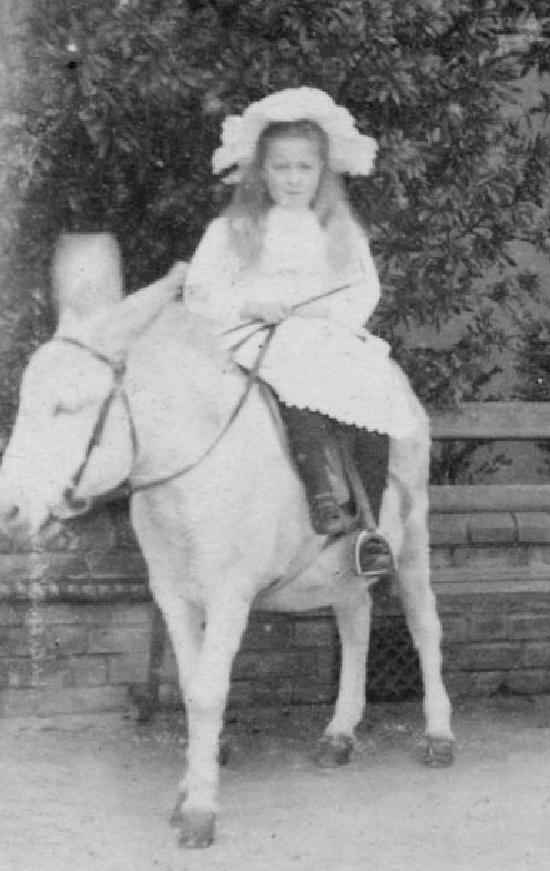
Horse Back Riding: Riding Styles

Figure 1.--This is an unidentified CDV that a HBC reader dates to around 1880, based on the thickness of the card, rounded corners etc. (HBC might guess the later 1880s based on the sailorsuit styles.) Three siblings (I'm assuming) upon their ponies/donkeys. The girl as you can clearly see is riding side-saddle, something that women horse-riders have been doing for hundreds of years apparently. Image courtesy of the MD collection. Click on the image to see the entire portrait with her brothers.
|
There are two principal riding styles, astride and side saddle. Girls would be taught to ride side saddle and boys astride. Almost all girls and women from affluent families in the 19th century rode side saddle. As they did not wear pants, side saddle was the only way that they could modestly ride. Riding side saddle was, however, a much more difficult way to ride. Several different types of side saddles exist. In general terms, most people would probably think of a side-saddle as an English saddle. However, there are also Western side-saddles. Some are "balanced ride" saddle, which means the stirrup leathers are
hung farther forward than normal and are bolted to the tree instead of looped over the bars. It is made on a Wade tree with in skirt rigging, a 3/4 padded seat and corner tooling with the Wild Rose pattern. Cantle and horn are rawhide bound. Girls from the gentry would be expected to ride side saddle. I'm not sure that the same was true for more humble families in the countryside.
Men from the time of the domestication of the horse have riden astride. This became even more significant with the invention of stirups. This allowed the a rider the support needed to strike a forceful when mounted. European women did not commonly ride astride until after World War I. After the War, woman for the first time would appear in pants. One of the types of pants were jodpurs or riding pants. So dressed it was possible for girls to modestly ride astride. We have noted portraits of boys riding hobby horses side saddle, or at least photographed sitting side saddle. We have not yet noted boys in dresses riding actual horses side saddle. All of the images we have noted when the child has been confirmed as a boy were riding side saddle. There are unidentified images that we are unsure about, as it is so difficult to be sure about the gender of younger children in old photographs. As far the identifed images or images that seem to be definitely boys, all show boys riding stride.
Girls would be taught to ride side saddle and boys astride. Almost all girls and women from affluent families in the 19th century rode side saddle. As they did not wear pants, side saddle was the only way that they could modestly ride. Riding side saddle was, however, a much more difficult way to ride. Several different types of side saddles exist. In general terms, most people would probably think of a side-saddle as an English saddle. However, there are also Western side-saddles. Some are "balanced ride" saddle, which means the stirrup leathers are hung farther forward than normal and are bolted to the tree instead of looped over the bars. It is made on a Wade tree with in skirt rigging, a 3/4 padded seat and corner tooling with the Wild Rose pattern. Cantle and horn are rawhide bound. Girls from the gentry would be expected to ride side saddle. I'm not sure that the same was true for more humble families in the countryside. Side-saddle riding disappeared after World War I when women began wearing pants.
HBC

Navigate the Boys' Historical Clothing Web Site:
[Return to the Main horeback riding page]
[Return to the Main activities page]
[Introduction]
[Activities]
[Biographies]
[Chronology]
[Clothing styles]
[Countries]
[Girls]
[Bibliographies]
[Contributions]
[FAQs]
[Glossary]
[Satellite sites]
[Tools]
[Boys' Clothing Home]
Created: June 26, 2003
Last updated: June 26, 2003



